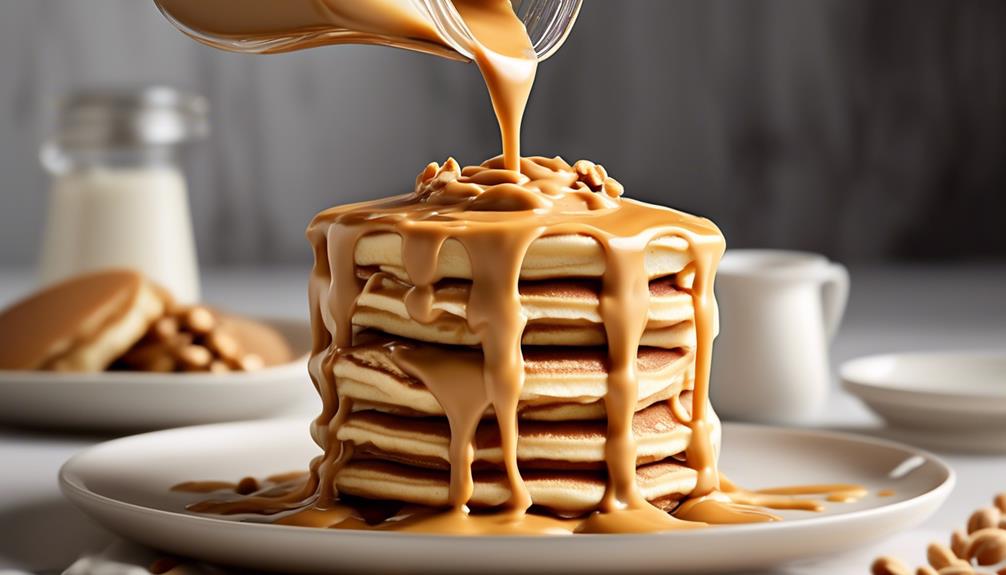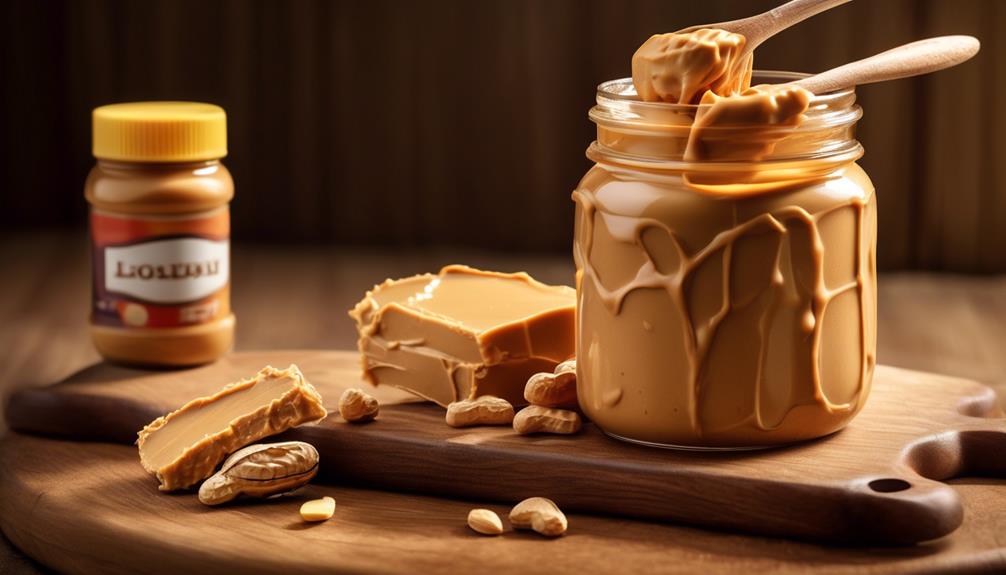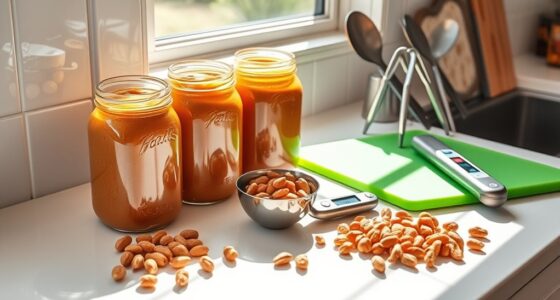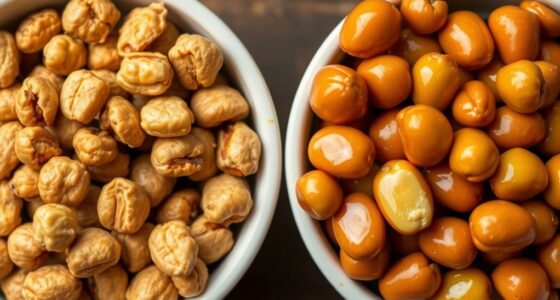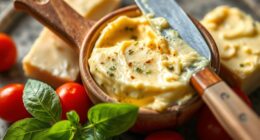We've all heard of the peanut butter shot, but did you know that it's one of the most searched for terms related to peanut butter? With its mysterious name and elusive presence, the peanut butter shot seems to have captured the curiosity of many.
But where exactly can one find this enigmatic concoction? Is it a rare specialty at a hidden gem of a bar, or is it a DIY creation that's been making waves online?
Join us as we explore the world of the peanut butter shot and uncover its secrets.
Key Takeaways
- The Peanut Butter Shot originated as part of the US Military's medical evaluation process for recruits.
- It contains Bicillin, a form of penicillin, and is administered through injection into the buttocks.
- The shot is widely available and is a standard part of medical evaluations for military recruits in various countries.
- Its use in the military underscores its importance in protecting the health and safety of military personnel.
History of the Peanut Butter Shot
The history of the peanut butter shot can be traced back to its introduction as a vital part of the military's medical evaluation process for recruits. In the early days of the US Military, particularly in the Marine Corps, the need for an effective and long-lasting vaccination against bacterial infections became increasingly apparent. This led to the development and eventual implementation of the bicillin vaccination, colloquially known as the peanut butter shot.
Its thick, paste-like consistency provided a slow absorption rate, ensuring an extended protective effect for the recruits. The peanut butter shot quickly became a standard procedure during medical evaluations in boot camp, aimed at safeguarding the health of service members.
The introduction of the peanut butter shot marked a significant advancement in preventive medicine within the military. While its administration has garnered a reputation for discomfort, its crucial role in protecting recruits from potentially harmful bacterial infections can't be overstated.
The history of the peanut butter shot reflects the US Military's commitment to ensuring the well-being of its personnel through rigorous medical evaluations and preventive healthcare measures.
Ingredients of the Peanut Butter Shot

Comprising Bicillin, a form of penicillin utilized for preventing and treating bacterial infections, the Peanut Butter Shot is known for its thick, creamy consistency reminiscent of peanut butter. Along with Bicillin, the shot may contain stabilizers, preservatives, and other components to maintain the medication's efficacy. These additional ingredients are carefully selected to ensure the stability and effectiveness of the medication.
When administered, the shot is carefully injected into the buttocks with a thick needle by trained medical staff, allowing for deep intramuscular absorption. The Bicillin within the shot is designed to be slowly absorbed by the body, providing a prolonged effect, making it a suitable choice for certain medical situations.
This unique combination of ingredients and the method of administration make the Peanut Butter Shot an essential part of medical care, particularly in environments like boot camps where preventing and treating bacterial infections is crucial. The thick liquid nature of the shot ensures that the medication is delivered effectively and can begin working efficiently at the injection site.
Popular Variations of the Peanut Butter Shot

Exploring the Peanut Butter Shot's realm includes discovering its various adaptations and applications in medical settings, reflecting its significance in diverse healthcare scenarios.
Among medical staff, the peanut butter shot is commonly known as the 'penicillin shot' due to its thick, peanut butter-like consistency. This injection, administered to recruits in boot camp, is a popular variation of the peanut butter shot.
The shot contains a medication called bicillin, which is used to prevent and treat bacterial infections. Its thick liquid form allows for a slow release of the medication, providing long-lasting effects and reducing the need for frequent dosing.
This variation of the peanut butter shot is particularly favored in the military setting due to its convenience and effectiveness in ensuring recruits receive necessary immunization and treatment, especially in high-intensity training environments.
Its adaptability in delivering medication efficiently makes it a valuable tool in healthcare, underscoring the diverse roles the peanut butter shot plays within medical contexts.
Serving Locations for the Peanut Butter Shot

When it comes to serving locations for the peanut butter shot, there are several popular options that we've observed. From college bars to trendy cocktail lounges, this unique shot has found its place on menus across a variety of establishments.
We'll explore the different settings where this shot has gained popularity and discuss the appeal of these locations for serving the peanut butter shot.
Shot Locations
The peanut butter shot is typically administered in the upper outer quadrant of the buttocks, known as the dorsogluteal area. When receiving the injection, recruits in boot camp are usually directed to lie on their stomach or stand and lean forward.
The medical staff will then locate the injection site, sanitize the area, and administer the peanut butter shot using a syringe. It's essential for medical staff to ensure proper technique and accuracy to minimize discomfort and potential complications.
After the injection, recruits may experience soreness, swelling, and difficulty sitting due to the thick consistency of the medication. Despite these discomforts, the shot location is chosen for its relative safety and efficacy in delivering the necessary medication to prevent bacterial infections.
Popular Peanut Butter Shots
Serving locations for the popular peanut butter shot often vary depending on the specific setting and medical protocol. This medication, administered via injection, is commonly given to recruits in military boot camps.
The peanut butter shot, known for its thick and oily consistency, is officially called the benzathine penicillin G injection. It's a popular choice for preventing diseases like syphilis and other bacterial infections due to its long-acting nature.
Medical staff at boot camps and military training facilities are responsible for administering this shot to ensure the health and well-being of the recruits. The shot's popularity stems from its effectiveness in preventing the spread of infectious diseases in close living quarters, making it a crucial part of the medical protocol in such environments.
Making the Peanut Butter Shot at Home

When it comes to making the peanut butter shot at home, it's important to understand the ingredients and the steps involved in preparing the shot.
We'll need to gather the necessary supplies and follow specific instructions to ensure its effectiveness and safety.
Ingredients for Peanut Butter Shot
If you're a fan of the Peanut Butter Shot and want to recreate it at home, you'll need to gather a few key ingredients to ensure an authentic and delicious result.
Here are the essential ingredients for making the Peanut Butter Shot at home:
- B-12 Injections: These are crucial as they provide the medical benefits of the original Peanut Butter Shot.
- Peanut Butter Flavored Liquor: This adds the distinct nutty flavor to the shot. Look for high-quality options for the best taste.
- Cream Liqueur: To achieve the thick liquid consistency, a cream liqueur, such as Irish cream, is necessary.
- Medication Syringe: For accurate measurements and to capture the essence of the original medical context.
Steps to Prepare Shot
To recreate the Peanut Butter Shot at home, it's essential to gather the necessary ingredients, including B-12 injections, peanut butter flavored liquor, cream liqueur, and a medication syringe, maintaining the authenticity and flavor of the original while ensuring accurate measurements and a medical context.
Once the ingredients are assembled, it's crucial to create a clean and sterile environment for preparation. Sterilize the injection site with an alcohol swab and carefully draw the appropriate doses of the liquors into the syringe, following proper measurement and handling procedures.
When administering the shot, it's important to inject it into the muscle tissue using proper technique and caution. Ensure safe disposal of used needles and other medical waste, and store any remaining liquor as directed.
Recreating the Peanut Butter Shot at home requires attention to detail and adherence to medical best practices, mirroring the care provided by trained medical staff in a boot camp or vaccination setting.
Peanut Butter Shot: A Tasting Guide

The peanut butter shot, despite its unappetizing name, is a crucial vaccination administered to military recruits for bacterial protection. As recruits, we quickly become acquainted with the infamous peanut butter shot during our time at boot camp. The experience of receiving this injection is unlike any other; the medical staff prepares us for the excruciating pain that follows.
Here's a guide to navigating the unique 'tasting' experience of the peanut butter shot:
- Prepare Mentally: Steel yourself for the thick consistency of the injection and the discomfort that ensues.
- Seek Support: Lean on fellow recruits for encouragement and understanding, as they're going through the same experience.
- Follow Aftercare Instructions: Take care of the injection site as directed by medical staff to minimize post-injection discomfort.
- Stay Resilient: Remember that the pain is temporary and part of the process of becoming a military service member.
The peanut butter shot, while daunting, serves as an introduction to the challenges and resilience required in military life. As recruits, we endure this experience together, emerging stronger and more prepared for the rigors of service.
Health and Safety Considerations

With careful consideration for the health and safety of recruits, screening for allergies before administering the peanut butter shot is an essential protocol. It's crucial to prioritize the well-being of the recruits by ensuring that medical staff are well-equipped to handle any adverse reactions. The following table outlines key health and safety considerations for the administration of the peanut butter shot:
| Health and Safety Considerations | Description |
|---|---|
| Allergy Screening | Recruits must be screened for peanut allergies before receiving the injection to prevent severe allergic reactions. |
| Injection Technique | Medical staff should be trained in proper injection techniques to minimize the risk of adverse effects such as skin discoloration or blisters. |
| Side Effects Management | Recruits should be informed about potential side effects, including pain and restricted movement, and provided with aftercare instructions. |
It's essential to acknowledge the potential discomfort and fear associated with the peanut butter shot, creating a supportive environment for recruits. By prioritizing health and safety considerations, recruits can receive the necessary care and support to manage any side effects and ensure their well-being throughout the medication process.
Cultural Significance of the Peanut Butter Shot

Exploring the cultural significance of the peanut butter shot reveals its impact on the shared experiences and rites of passage within military training.
The peanut butter shot, though a source of apprehension for recruits, holds a deep cultural significance within the military community.
Its role extends beyond that of a mere medical procedure, becoming a symbol of the physical and mental challenges faced during training.
The injection is administered by medical staff, marking the beginning of recruits' exposure to the healthcare protocols and practices prevalent in the military.
The discomfort caused by the shot becomes a shared experience, fostering camaraderie among recruits as they navigate the physical movement and training activities.
Moreover, the peanut butter shot is often viewed as a test of resilience, with those enduring its effects considered to have crossed a crucial threshold in their military journey.
As such, it has become an integral part of the cultural fabric of boot camps, representing the arduous yet transformative nature of military training.
Celebrity Endorsements of the Peanut Butter Shot

Despite its significant presence in military training, the peanut butter shot hasn't received any celebrity endorsements.
The peanut butter shot, also known as the adenovirus vaccine, is a mandatory injection given to recruits during boot camp. Its excruciating pain and association with military procedures have deterred any publicized celebrity endorsements.
The injection, administered by medical staff, is notorious for its intense soreness and discomfort, often leaving recruits with aching hips for days. Given these factors, it's understandable why celebrities haven't publicly endorsed or associated themselves with the peanut butter shot.
The military's strict vaccination requirements and the shot's painful reputation may be deterrents to potential celebrity endorsements. Although the peanut butter shot plays a crucial role in preparing recruits for their military service, it remains largely unnoticed by the public eye and hasn't garnered the attention of celebrities.
As such, it continues to be a significant yet uncelebrated aspect of military training.
The Future of the Peanut Butter Shot

The peanut butter shot, while currently lacking celebrity endorsements, remains a critical component of military training, prompting consideration for potential advancements and improvements in its administration and effectiveness in the future.
As medical staff, we recognize the need for innovation to enhance the experience of recruits receiving this injection while maintaining its vital role in preventing bacterial infections.
In exploring the future of the peanut butter shot, several aspects could be considered:
- Development of a faster-absorbing formulation to minimize discomfort for recruits.
- Implementation of alternative administration methods to reduce the pain associated with the injection.
- Research into potential medications with similar prolonged effectiveness but with a less painful delivery method.
- Integration of comprehensive pre-injection education and post-injection care to alleviate fear and discomfort for recruits.
These potential advancements could revolutionize the experience of recruits during boot camp medical evaluations, ensuring the continued effectiveness of the peanut butter shot while prioritizing the well-being and comfort of those receiving this essential medication.
Nutritional Value of the Peanut Butter Shot

Administering the peanut butter shot doesn't contribute to the nutritional intake of recruits, as it serves as a medical intervention rather than a source of dietary sustenance. The injection, while colloquially referred to as the 'peanut butter shot,' contains no actual peanut butter and doesn't possess any nutritional value. It's a crucial medication administered by the medical staff during boot camp to prevent and treat bacterial infections.
This shot, a form of penicillin, is essential for safeguarding the health of recruits in the rigorous training environment. Its primary purpose is to provide broad-spectrum protection against various bacteria, rather than serving as a source of dietary nutrition. Recruits receive this standard vaccination as part of their processing week in boot camp, ensuring their overall well-being and ability to endure the physical demands of military training.
Thus, while the 'peanut butter shot' is a distinctive aspect of the military experience, it's important to recognize its role as a medical intervention and not a source of nutritional sustenance.
Comparing the Peanut Butter Shot to Other Shots

Comparing the peanut butter shot to other shots reveals the distinctive medical interventions provided to recruits during boot camp, each serving specific roles in safeguarding their health and well-being. The peanut butter shot, also known as the penicillin injection, is administered to prevent diseases like pneumonia and meningitis in the close living quarters of boot camp. This injection is just one of the many medical interventions recruits receive as part of their comprehensive healthcare regimen.
Here's how the peanut butter shot stacks up against other essential shots:
- Peanut Butter Shot (Penicillin Injection): Given to prevent infections in close living quarters.
- Influenza Vaccine: Administered to prevent the spread of seasonal flu among recruits.
- Tetanus Shot: Protects against tetanus, a bacterial infection that can enter the body through cuts or wounds.
- Hepatitis B Vaccine: Given to protect against a potentially serious liver infection caused by the hepatitis B virus.
Each of these injections plays a crucial role in ensuring the health and well-being of recruits during intense training at boot camp, and they're carefully administered by knowledgeable medical staff.
Global Availability of the Peanut Butter Shot

The peanut butter shot, also known as the bicillin vaccination, is widely available across the globe and is a standard part of medical evaluations for military recruits in various countries.
Military bases in the United States, United Kingdom, Canada, Australia, and others administer this vaccination as a preventive measure against bacterial infections.
Its global availability reflects its crucial role in ensuring the health and safety of military personnel during training and deployment.
Availability in Countries
In countries where military recruitment and training are integral to national defense, the peanut butter shot, also known as the Bicillin vaccination, is widely available as part of the standard medical evaluations undergone by military recruits during their initial training. This injection is a crucial component of the healthcare protocols for military personnel in various nations. The shot's availability is closely linked to the medical guidelines and practices of military institutions, ensuring its widespread administration in boot camps.
Medical staff are responsible for administering the peanut butter shot to recruits, adhering to specific immunization protocols. The availability of this vaccination is contingent on each country's military healthcare regulations, emphasizing its significance in preparing recruits for military service.
- The peanut butter shot is widely available in countries with active military forces.
- Availability is closely tied to the military's healthcare protocols and practices.
- Medical staff are responsible for administering the shot to recruits.
- The shot's availability is contingent on each country's specific military healthcare regulations and immunization protocols.
Military Use
Global military forces rely on the peanut butter shot, also known as the bicillin vaccination, as a crucial component of their medical evaluations for recruits during initial training. This injection, administered by medical staff during boot camp, is a standard procedure aimed at protecting recruits from bacterial illnesses.
The peanut butter shot contains bicillin, effectively targeting various bacteria strains in one dose. While it's a routine part of military medical evaluations, recruits with proven allergies to the medication are exempt. Those with allergies receive alternative medications or treatments.
Despite its effectiveness, the peanut butter shot is often dreaded by recruits due to the pain and discomfort it causes. Nevertheless, its widespread use underscores its importance in safeguarding the health of military personnel during their rigorous training and service.
Frequently Asked Questions
Where Is the Peanut Butter Shot Given?
We receive the peanut butter shot, also known as the bicillin vaccination, in the butt cheek during military medical evaluations in boot camp. It's a standard procedure, given unless there's a proven allergy to the medication.
Though it can be feared due to the pain and slow absorption rate, it effectively protects us from bacterial illnesses.
The shot is a necessary part of the process, introducing us to medical procedures and challenges in the military.
Is the Peanut Butter Shot Discontinued?
No, the peanut butter shot isn't discontinued. It's still administered in many military bases.
The shot, known for its thick, peanut butter-like consistency, is a standard procedure in military medical evaluations, given to recruits during boot camp. Although feared for its pain, it remains a part of the process unless recruits have a proven allergy to the medication.
Despite rumors, the discontinuation of the peanut butter shot isn't officially confirmed.
Why Do Military Get Peanut Butter Shot?
We get the peanut butter shot in the military to prevent bacterial infections. It's thick, like peanut butter, and is administered in the butt cheek. The shot provides broad-spectrum protection and is a necessary part of our medical evaluations during boot camp.
Although it's feared due to the pain it causes, it's an introduction to the challenges we'll face in the military. Recruits with allergies are exempt, and alternative treatments are provided.
Can You Be Exempt From the Peanut Butter Shot?
We can't be exempt from the peanut butter shot, as it's a mandatory vaccine for military personnel. It's given to protect against infectious diseases.
The shot's nickname comes from its color and consistency, resembling peanut butter. It's usually administered as a series of three injections and is essential for deployment to certain high-risk areas.
While it may not be a pleasant experience, it's an important part of maintaining the health and safety of military members.
Conclusion
In conclusion, the peanut butter shot has a rich history and is enjoyed by many around the world.
Interestingly, it's estimated that over 1 million peanut butter shots are administered annually in the United States military as part of basic training.
The shot's unique ingredients and variations make it a popular choice for those looking for a flavorful and effective way to boost their energy.
Its availability globally continues to grow, making it a sought-after beverage option.

